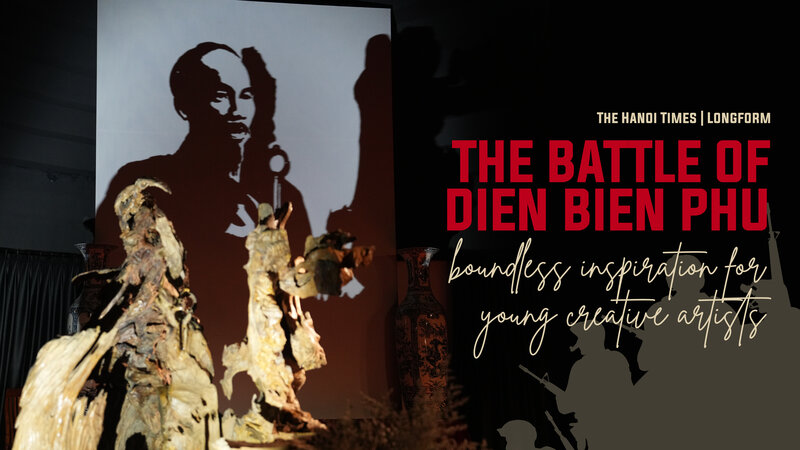

May 08, 2024
TEXT SIZE
removeaddOver the past 70 years, the victory of the Battle of Dien Bien Phu has inspired Vietnamese artists to create their masterpieces, telling the story and values of the glory of world history.
With boundless creativity and passion, young artists in Hanoi have created outstanding works of art to commemorate the 70th anniversary of the victory and pay tribute to the heroes, martyrs, and others who laid down their lives for national sovereignty and independence.
These artistic creations are also intended to instill in the Vietnamese people, especially the younger generations, a love for the country, its people, and its history.
In the early days of May, the exhibition on the fourth floor of the Bat Trang Pottery Museum in Gia Lam District is packed with visitors to see artist Bui Van Tu’s masterpiece.
In the room, a sculpture made of wooden sticks, parcels, and leaves seems to be arranged in no particular order, leaving the question open as to whether the artwork is finished.
Seeing the bewilderment of the visitors, the 32-year-old artist turns on the lights and rotates the sculpture. Its shadow appears on a screen behind it, revealing a porter steering his xe tho (cargo bike) up the mountain path.
According to the War Remnants Museum, cargo bikes were the main means of transport during the Dien Bien Phu campaign for their versatility and cargo capacity.
Unofficially dubbed “The Force of Cargo Bike”, the cargo bikers had to travel a long distance of 1,500 kilometers from other provinces to deliver supplies to the battlefields of Dien Bien Phu.
Ma Van Thang, who lives in Phu Tho Province, earned his fame for carrying 325 kilograms of supplies to the frontline, which is 13 times his weight as a porter.
A normal bicycle is transformed into a cargo one by adding a one-meter long bamboo pole for steering. Another small 50-centimeter bamboo pole is tied to the seat to allow the cargo biker to push the bike forward.
Tu’s artwork is so detailed, well-made, and well-designed that visitors can see all of these details crystal clear.
But there’s more magic in the artwork.
Tu rotates the sculpture again. In a different position, the shadow turns into the image of three Vietnamese soldiers raising and waving the national flag at the top of De Castries' bunker.
Tu entitled his sculpture “The Soldiers of Dien Bien”. He has also created two other sculptures depicting General Vo Nguyen Giap and President Ho Chi Minh. The three works are part of his collection “The Legend of Dien Bien”.
The young artist then leads visitors through another light sculpture called “The Pride of Vietnam”. This time, the light show recreates the scene of President Ho Chi Minh reading the Declaration of Vietnam’s Independence, the Communist Party flag, the national flag, and the map of Vietnam with the Truong Sa and Hoang Sa archipelagoes.
“Through the artworks, I want to emphasize that the ideas of Uncle Ho and the Party are the beacon that led the army and people to the historic victory of Dien Bien Phu,” Tu said.
Last week, the Vietnam Circus Federation unveiled a piece called “Living Memories of Dien Bien”. It told of the glory of 70 years ago. The show started with joy and jubilation after the Vietnamese army won the hard-fought battle to regain national independence.
Directed by People’s Artist Tong Toan Thang, Director of the Vietnam Circus Federation, the show took the audience through a range of emotions. In a 90-minute performance, the artists recreated the atmosphere of excitement, resilience, and passion as cargo bikers, played by the circus performers, transported supplies to the frontlines and fought the enemy.
The most iconic scene of the battle, the dragging of artillery over the high mountain, is also re-enacted. The artists depicted a group of soldiers carrying the artillery on their shoulders to higher ground in the reign of fire.
Particularly noteworthy is the scene in which soldier To Vinh Dien heroically throws himself onto the artillery wheel to prevent it from rolling down the mountain.
“It’s an emotional and proud scene,” said Artist Nguyen Ha Binh of the Vietnam Circus Federation. “It is a challenging task for me. I had to read a lot of historical materials, watch documentaries about the campaign, and listen to the director’s instructions to render the full spirit of the character.”
Aside from the artillery-stopping scene, audiences are also touched by the depiction of the Battle of Him Lam, where soldier Phan Dinh Giot used his body to cover the arrow slit to prevent the opposing side from shooting at his comrades, or the scene where soldier Be Van Dan used his shoulder as a tripod for his comrades to place the machine gun.
Artist Nguyen Manh Thuong, who played the character Be Van Dan, said: "I try my best to portray the character who endured the machine gun, which was overheated from so many shots, on his shoulder.”
“In this scene, we have to climb on top of each other to show the soldiers rising up to take over the base. We have to strongly personify ourselves as soldiers so that the audience can feel the glory when the national flag is raised on the roof of the bunker.”
People’s Artist Tong Toan Thang said: “Every scene is designed to touch the audience at the deepest level. Using the language of the circus, we try to recreate the fights, make the audience completely immersed in emotions, and praise those who sacrificed for the country.”
By turning the circus stage into a large war map, the show “Living Memories of Dien Bien” will be a great show telling a heroic, brave, and epic period of Vietnam’s history, he said.
Hanoitimes © Copyright 2014-2019